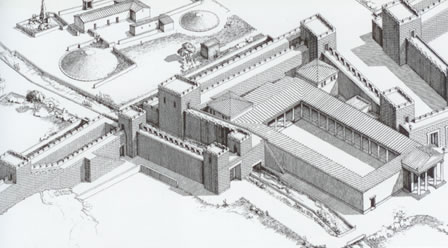 The Pompeion, from the Greek ‘pompe’ (procession) was the place of gathering for the Panathenaic procession, which was held in celebration of the tutelary goddess of the city, Athena. Here also a wooden ship was stored, which was carried to the Acropolis in the procession, its mast decorated with the peplos (woolen garment) that was to be presented to the goddess in her temple.
The Pompeion, from the Greek ‘pompe’ (procession) was the place of gathering for the Panathenaic procession, which was held in celebration of the tutelary goddess of the city, Athena. Here also a wooden ship was stored, which was carried to the Acropolis in the procession, its mast decorated with the peplos (woolen garment) that was to be presented to the goddess in her temple.
The Pompeion is tucked away between the Sacred and the Dipylon gates and owes its asymmetrical plan to the irregularity of the building plot. Its remains are partially covered by buildings of the Roman period, but can be traced with the help of the plan on the information board installed at the site.
The Pompeion was built around 400 BC, when Athens was still trying to recover from the Peloponnesian War, and is much more modest than buildings erected earlier in the 5th century BC at the height of the city’s power. Its most monumental part is the elaborate, marble gateway (or propylon) on the eastern side. The sloping ramp suffered from quite some traffic, as witnessed by the clearly visible wheel ruts. From the propylon one enters the large court, which was surrounded by Ionic columns. Some of the youngsters, apparently getting bored while waiting for the procession to begin, carved their names on the walls (as visible next to the door in the southeast corner of the court).
At the west and northwestern side of the building are dining rooms, offering distinguished participants in the Panathenaic festival a quiet place to dine and drink after the procession and ceremonies on the Acropolis were concluded. An ancient inscription states that the meat from the animals sacrificed to Athena had to be shared out in the Kerameikos, something that seems born out by the discovery of large quantities of cattle bones.
The floors of the dining rooms were simply made of sea pebbles, but Room 6 had a small mosaic with animal fight. This is one of the earliest figurative mosaics in Greece and is on display in the front yard of the Kerameikos Museum.
The Classical Pompeion was destroyed in the attack by the Roman general Sulla in 86 BC. (Note the stone catapult balls that lie around the area). In the 2nd century AD a three-aisled storehouse was erected over its ruins. This storehouse was destroyed in the Herulian raid of 267 AD. The third building to go up on the site was 4th century AD ‘shopping mall’, consisting of two long stoas and a gate. In intermediate periods the area was used by potters, who have left us a number of kilns.